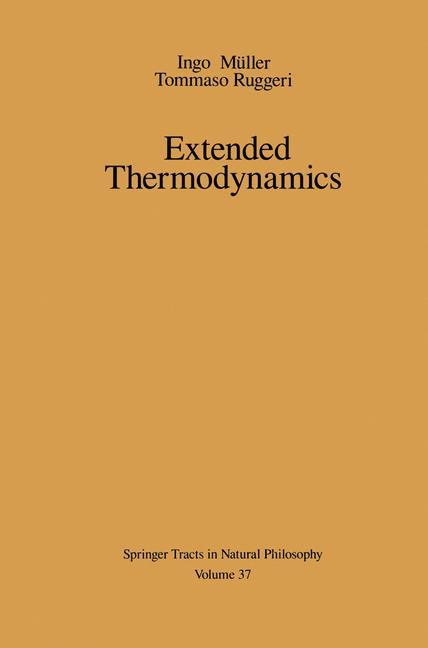
Zustellung: Mi, 17.09. - Di, 23.09.
Versand in 5 Wochen
VersandkostenfreiBestellen & in Filiale abholen:
Physicists firmly believe that the differential equations of nature should be hyperbolic so as to exclude action at a distance; yet the equations of irreversible thermodynamics - those of Navier-Stokes and Fourier - are parabolic. This incompatibility between the expectation of physicists and the classical laws of thermodynamics has prompted the formulation of extended thermodynamics. After describing the motifs and early evolution of this new branch of irreversible thermodynamics, the authors apply the theory to mon-atomic gases, mixtures of gases, relativistic gases, and "gases" of phonons and photons. The discussion brings into perspective the various phenomena called second sound, such as heat propagation, propagation of shear stress and concentration, and the second sound in liquid helium. The formal mathematical structure of extended thermodynamics is exposed and the theory is shown to be fully compatible with the kinetic theory of gases. The study closes with the testing of extended thermodynamics through the exploitation of its predictions for measurements of light scattering and sound propagation.
Inhaltsverzeichnis
1 Early Version of Extended Thermodynamics and Kinetic Theory of Gases. - 1 Paradoxa of Heat Conduction and Shear Diffusion. - 1. 1 Heuristic Derivation of the Laws of Fourier and Navier-Stokes. - 1. 2 Parabolic Laws of Heat Conduction and Shear Diffusion. - 2 Paradox Removed. - 2. 1 The Cattaneo Equation. - 2. 2 Extended TIP. - 2. 3 Finite Pulse Speeds in Extended TIP. - 2. 4 Conclusion and Criticism. - 3 Kinetic Theory of Mon-Atomic Gases. - 3. 1 Boltzmann Equation and Moments. - 3. 2 Equations of Balance for Moments. - 3. 3 Balance of Entropy and Possible Equilibria. - 3. 4 The Grad Distribution. - 3. 5 Entropy and Entropy Flux in Grad's 13-Moment Theory. - 3. 6 Phenomenological Equations Derived from the Kinetic Theory. - 3. 7 Pulse Speeds. - 3. 8 Conclusions. - 2 Extended Thermodynamics of Mon-Atomic Gases. - 1 The Equations of Extended Thermodynamics of Mon-Atomic Gases. - 1. 1 Thermodynamic Processes. - 1. 2 Discussion. - 1. 3 Galilean Invariance: Convective and Non-Convective Fluxes. - 1. 4 Euclidean Invariance: Inertial Effects. - 2 Constitutive Theory. - 2. 1 Restrictive Principles. - 2. 2 Exploitation of the Principle of Material Frame Indifference. - 2. 3 Exploitation of the Entropy Principle. - 2. 4 Exploitation of the Requirement of Convexity and Causality. - 3 Field Equations and the Thermodynamic Limit. - 3. 1 Field Equations. - 3. 2 The Thermodynamic Limit. - 3. 3 The Frame-Dependence of the Heat Flux. - 4 Thermal Equations of State and Specific Equation for Ideal Gases. - 4. 1 The Classical Ideal Gas. - 4. 2 Comparison with the Kinetic Theory. - 4. 3 Comparison with Extended TIP. - 4. 4 Degenerate Ideal Gases. - 3 Thermodynamics of Mixtures of Fluids. - 1 Ordinary Thermodynamics of Mixtures (TIP). - 1. 1 Constitutive Equations. - 1. 2 Paradox of Diffusion. - 2 Extended Thermodynamics of Non-Viscous Simple Mixtures. - 2. 1 Balance Equations. - 2. 2 Thermodynamic Processes. - 2. 3 Constitutive Theory. - 2. 4 Summary of Results. - 2. 5 Wave Propagation in a Non-Reacting Binary Mixture. - 2. 6 Landau Equations: First and Second Sound in He II. - 3 Ordinary and Extended Thermodynamics of Mixtures. - 3. 1 The Laws of Fick and Fourier in Extended Thermodynamics. - 3. 2 Onsager Relations. - 3. 3 Inertial Contribution to the Laws of Diffusion. - 4 Relativistic Extended Thermodynamics of Mon-Atomic Gases. - 1 Balance Equations and Constitutive Restrictions. - 1. 1 Thermodynamic Processes. - 1. 2 Principles of the Constitutive Theory. - 2 Constitutive Theory. - 2. 1 Scope and Structure. - 2. 2 Lagrange Multipliers and the Vector Potential. - 2. 3 Principle of Relativity and Linear Representations. - 2. 4 Stress Deviator, Heat Flux, and Dynamic Pressure. - 2. 5 Fugacity and Absolute Temperature. - 2. 6 Linear Relations Between Lagrange Multipliers and n, UA, t, ? , qA, e. - 2. 7 The Linear Flux Tensor. - 2. 8 The Entropy Flux Vector. - 2. 9 Residual Inequality. - 2. 10 Causality and Convexity. - 2. 11 Summary of Results. - 3 Identification of Viscosities and Heat Conductivity. - 3. 1 Extended Thermodynamics and Ordinary Thermodynamics. - 3. 2 Transition from Extended to Ordinary Thermodynamics. - 4 Specific Results for Relativistic and Degenerate Gases. - 4. 1 Equilibrium Distribution Function. - 4. 2 The Degenerate Relativistic Gas. - 4. 3 Non-Degenerate Relativistic Gas. - 4. 4 Degenerate Non-Relativistic Gas. - 4. 5 Non-Degenerate Non-Relativistic Gas. - 4. 6 Strongly Degenerate Relativistic Fermi Gas. - 4. 7 A Remark on the Strongly Degenerate Relativistic Bose Gas. - 4. 8 Equilibrium Properties of an Ultrarelativistic Gas. - 5 Two Applications. - 5. 1 The Limit Mass of White Dwarfs. - 5. 2 Thermo Acceleration Waves. - 6 The Relativistic Kinetic Theory for Non-Degenerate Gases. - 6. 1 Boltzmann-Chernikov Equation. - 6. 2 Equations of Transfer. - 6. 3 Equations of Balance for Particle Number, Energy-Momentum, Fluxes, and Entropy. - 6. 4 Maxwell-Jüttner Distribution: Equilibrium Properties. - 6. 5 Possible Thermodynamic Fields in Equilibrium. - 7 The Non-Relativistic Limit of Relativistic Thermodynamics. - 7. 1 The Problem. - 7. 2 Variables and Constitutive Quantities. - 7. 3 The D
Produktdetails
Erscheinungsdatum
12. März 1993
Sprache
englisch
Untertitel
'Springer Tracts in Natural Philosophy'.
Auflage 1993.
XI, 230 pp. 43 figs.
Sprache: Englisch.
Auflage
1993
Seitenanzahl
230
Reihe
Springer Tracts in Natural Philosophy
Autor/Autorin
Ingo Müller, Tommaso Ruggeri
Illustrationen
XI, 230 pp. 43 figs.
Verlag/Hersteller
Produktart
gebunden
Abbildungen
XI, 230 pp. 43 figs.
Gewicht
530 g
Größe (L/B/H)
241/164/16 mm
ISBN
9780387979229
Entdecken Sie mehr
Bewertungen
0 Bewertungen
Es wurden noch keine Bewertungen abgegeben. Schreiben Sie die erste Bewertung zu "Extended Thermodynamics" und helfen Sie damit anderen bei der Kaufentscheidung.










